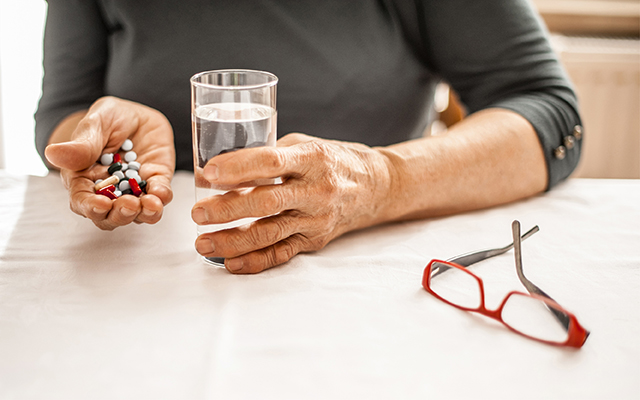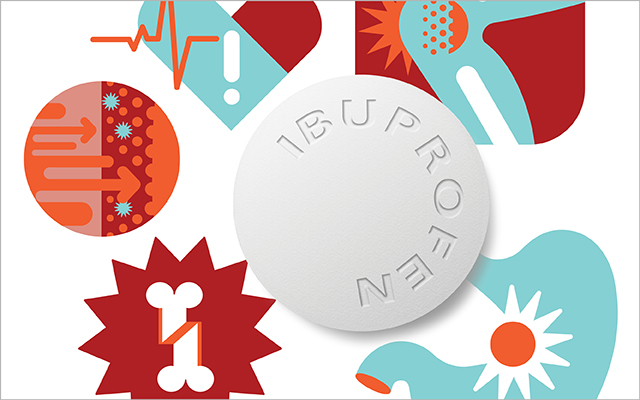There were no gifts to open this Christmas, as the pandemic prevented a gathering of our clan, but that doesn’t mean I emerged from the holiday empty-handed. Christmas Day delivered an excruciating sinus infection, which tested my pain threshold as well as my longstanding aversion to conventional treatment strategies. For the next week, I struggled to quiet the throbbing in my head with deep breathing, two varieties of herbal teas, echinacea, some homeopathic remedies, and a series of barely muted sighs of desperation.
Finally, after a number of sleepless nights, I stumbled out of bed around 4 a.m. one morning and began ransacking the hall closet seeking some relief. I recalled taking an aspirin at some point back in 2017 and knew there had to be a bottle somewhere in the house. Finding nothing amid the nutritional supplements and homeopathy, I turned my fevered gaze to the bathroom cabinet, with its essential oils, aloe vera, and neti pot. There, hidden behind the arnica gel and calendula cream was a tiny bottle of deliverance — aspirin, with an expiration date of 2012.
Nine years is barely a wink of an eye in the grand scheme of the universe, I wagered and downed a couple of tablets with a splash of water from the bathroom sink. The throbbing pain eventually subsided, and I slipped into a soothing slumber.
I took two more in the morning and asked My Lovely Wife to replenish our supply of pain relief with something of a more recent vintage. Meanwhile, I was left to contemplate my pathetic descent into the Big Pharma vortex.
For as long as I can remember, I’ve deflected the advice of physicians peddling pharmaceuticals as a preventive healthcare strategy. By their calculations, I should be taking a cholesterol-lowering statin, an ACE inhibitor for my blood pressure, and maybe even some metformin as a hedge against diabetes. Basic stuff for your average American geezer, 80 percent of whom take at least two prescription drugs daily.
But, as I meander into my eighth decade, I’m steadfastly convinced of the body’s ability to heal itself without consistent pharmaceutical intervention. And I’d rather not support an industry that has been preying on the American consumer so rapaciously for so long. A recent JAMA report, for instance, found that list prices for prescription drugs had doubled over a seven-year period.
Drug manufacturers argue that those list prices are a product of their research and development costs, but lead study author Eric Yang, MD, and his team found that “recent reports of substantial increases in list prices of drugs already on the market cannot be explained by development costs.”
Neither have the industry’s financial-assistance programs sufficiently offset the upward trend in drug prices over the years. “Despite rising manufacturer discounts and rebates,” Yang writes, “these price increases were associated with large increases in patient out-of-pocket costs and insurer payments.”
It’s a trend that hits those of us among the Medicare set harder than most. As Harris Meyer notes in Kaiser Health News, Medicare recipients have been lobbying Congress for years to set a more reasonable cap on drug copays, which rose to $6,550 this year. It’s an issue that enjoys bipartisan support — even the drug companies and insurers agree — but nobody wants to pay for it.
That leaves an awful lot of seniors dependent on grant programs operated by pharmaceutical companies and foundations to pay for their prescriptions, a strategy that often requires the active participation of physicians — most of whom can offer little or no help. “If I didn’t do really well at scrounging free drugs and getting copay foundations to work with us, my patients wouldn’t get the drug, which is awful,” oncologist Barbara McAneny, MD, past president of the American Medical Association, tells Meyer. “Patients would just say, ‘I can’t afford it. I’ll just die.’”
Ironically, experts argue this approach actually contributes to the rise in prices because it encourages doctors and patients to opt for the most expensive brands when cheaper varieties are available. I suspect most cancer patients are not much concerned about the macroeconomics of the drug industry when they’re searching desperately for a way to secure the medication they need to prolong their lives, but it strikes me as a particularly warped feature of the whole medical-pharmaceutical complex.
As broken as the Big Pharma pricing model is, though, it’s not the primary reason why I’ve chosen to steer clear of the pharmacy all these years. The real threat comes from what’s known as a “prescribing cascade,” when the side-effects of one medication lead to subsequent prescriptions leading to additional maladies. A popular hypertension medication, for example, has been shown in a Canadian study to cause swelling in the legs, which is then treated with a diuretic, which can cause dehydration, kidney troubles, and other side-effects, which may require yet another drug.
“Doctors are often taught to think of everything as a new problem,” explains Timothy Anderson, MD, an internist at Boston’s Beth Israel Deaconess Medical Center, in a recent New York Times piece. “They have to start thinking about whether the patient is on medication and whether the medication is the problem.”
My recent infatuation with aspirin, I know, does not necessarily portend some future cascade of prescriptions — or even a trip to the doctor — but it reminds me that conditions may arise that will force me to choose between alternative treatments and a pharmaceutical gambit. For all my commitment to the former and aversion to the latter, that’s one headache I’d rather avoid.




This Post Has 0 Comments